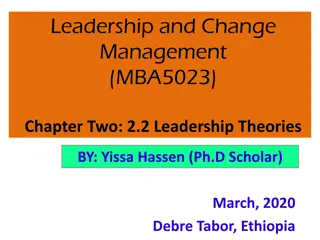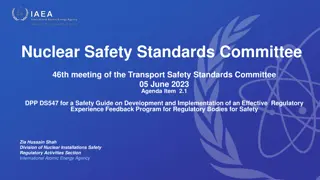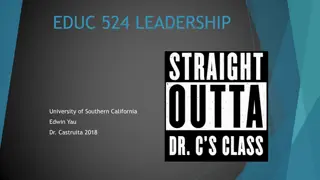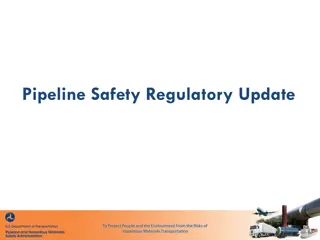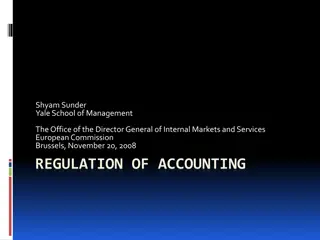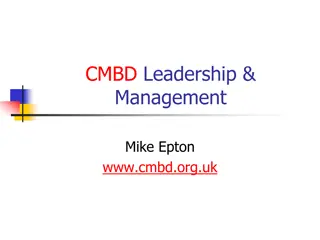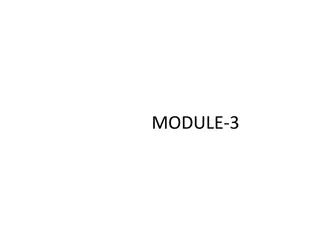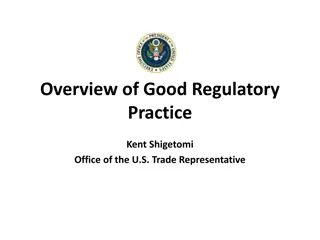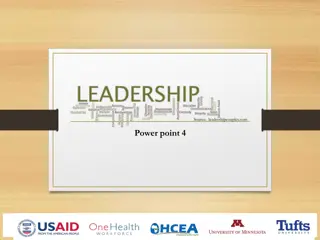
State Leadership in Current Regulatory Environment
Explore the key decision points and examples of state leadership in the evolving regulatory landscape affecting education. Learn about the impact of proposed ESSA regulations and the importance of accountability systems aligned with state standards for academic achievement.
Download Presentation

Please find below an Image/Link to download the presentation.
The content on the website is provided AS IS for your information and personal use only. It may not be sold, licensed, or shared on other websites without obtaining consent from the author. If you encounter any issues during the download, it is possible that the publisher has removed the file from their server.
You are allowed to download the files provided on this website for personal or commercial use, subject to the condition that they are used lawfully. All files are the property of their respective owners.
The content on the website is provided AS IS for your information and personal use only. It may not be sold, licensed, or shared on other websites without obtaining consent from the author.
E N D
Presentation Transcript
The current state of play Regulatory environment What is left to states II. Key decision points III. Examples of state leadership I. a. b. www.nasbe.org
Wall Street Journal: Biggest devolution of federal power in a quarter century. www.nasbe.org
With great power comes great responsibility.
USED has published proposed ESSA regulations: Accountability, reporting, state plans filed 8/1/16 Assessments filed 9/16 Innovative Assessments Pilot Supplement, not Supplant due 11/9 Fiscal rule, new interpretation would require state and local funding parity between Title I and non-Title I schools www.nasbe.org
Give a single summative test or break up the assessment into smaller components given throughout the year. Exempt 8th graders from middle grades math assessments under certain conditions Use adaptive assessments with conditions Include portfolios or performance tasks as part of the overall assessment www.nasbe.org
Develop accountability systems that Align with state academic standards Focus on student academic achievement and school success Include performance goals for each Annually measure student performance based on state assessments For high schools: annually measure graduation rates (4 year adjusted cohort rate) subgroup, www.nasbe.org
Include indicators focused on Academic achievement proficiency on annual assessments Student growth measures or another reliable and valid statewide indicator for elementary schools and non-high-school secondary schools The 4-year adjusted cohort grad rate (plus extended, at state s discretion) Progress in English language proficiency www.nasbe.org
The fifth indicator The fifth indicator Not less than 1 additional indicator of school quality or student success School climate and safety (how to measure) Educator engagement (again, how to measure) Attendance (average daily? Chronic absenteeism?) 6.5 million students 13 percent of all students missed 15 days or more of school in 2013-14. Access to (or completion of) advanced coursework Social and Emotional Learning www.nasbe.org
Course Course Schools with high enrollment of black & Latino students Schools with high enrollment of black & Latino students Schools with low enrollment of black & Latino students Schools with low enrollment of black & Latino students 33% 56% Calculus Calculus 48% 67% Physics Physics 65% 78% Chemistry Chemistry 71% 84% Algebra II Algebra II www.nasbe.org
States may continue to use their existing teacher evaluation system. But they are under no obligation to do so Highly qualified teacher requirement is eliminated. www.nasbe.org
Teacher equity even more important under ESSA states can use Title II formula funds for this purpose Student test scores not required to be part of teacher evaluation but many states will stay the course www.nasbe.org
States must annually identify schools for Targeted Support and Improvement : All schools with consistently underperforming subgroups www.nasbe.org
Every 3 years, identify schools for Comprehensive Support and Improvement The lowest performing 5 percent of Title I schools All high schools with graduation rates at or below 67 percent Schools with very low-performing subgroups that are not improving www.nasbe.org
States approve and monitor LEA plans for Comprehensive Support & Improvement LEA plans must: Be informed by all accountability indicators Include evidence-based interventions Be based on a school-level needs assessment Identify resource inequities and Be approved by the school and LEA www.nasbe.org
Accountability systems need to be designed according to a well-articulated theory of action that clearly lays out the intended goals and outcomes as well as proximal and intermediate indicators and the mechanisms and processes necessary to realize these goals. - Scott Marion National Center for the Improvement of Educational Assessment www.nasbe.org
Goals for Washington graduates Goals for Washington graduates All students should be prepared for Postsecondary education Gainful employment Citizenship www.nasbe.org
Take action on existing accountability policies (Achievement Index and Indicators of Educational System Health) Move towards broader system alignment (competency-based learning) Create a modern definition of career readiness www.nasbe.org
What is the goal? 100% proficiency ? Does a 100% goal lead to the Lake Woebegon Effect? (all the children are above average)? If 100% is not the goal, which kids get left out? Is the goal closing gaps? What is the state role in setting meaningful goals? How do those goals get translated into improvement targets for districts? How does all this affect district ratings? www.nasbe.org
School climate and safety (how to measure) Educator engagement (again, how to measure) Attendance (average daily? Chronic absenteeism?) 6.5 million students 13 percent of all students missed 15 days or more of school in 2013-14. Access to (or completion of) advanced coursework Social and Emotional Learning www.nasbe.org
There is a big difference between engaging people and having a meeting. From CCSSO s Stakeholder Engagement Guide www.nasbe.org
Goal to graduate KS students who are college and career ready The voice of parents, business, and local stakeholders wasn t part of the process. Board Chair Jim McNiece Focus groups, one-on-one conversations with more than 2,000 Kansans in more than 20 communities added more business leaders, who were undersampled at first www.nasbe.org
Board and Commissioner have now announced an initiative called Kansas Can Not a one and done approach Stakeholder engagement will continue www.nasbe.org
Goal is to graduate students who are college and career ready. Kentucky s College Kentucky s College- - and Career and Career- -Readiness Accountability Measures Readiness Accountability Measures College Ready 1 point College Ready 1 point Career Ready 1 point Career Ready 1 point College and Career Ready 1.5 points College and Career Ready 1.5 points A student must meet benchmarks on 1 of the following A student must meet benchmarks on one from each of the following columns: Career Ready Academic Career Ready Technical College Ready Academic College Ready Technical ACT or COMPASS or KYOTE ACT or COMPASS or KYOTE KOSSA or Industry Certificate ACT or COMPASS or KYOTE KOSSA or Industry Certificate ASVAB or Work Keys www.nasbe.org
What are the key decision points for the Washington SBE to focus on? What parts of your current system do you want to maintain? How should your accountability system change? How will stakeholders be involved after the plan is filed?
Kris Amundson kristen.amundson@nasbe.org 703-740-4821 www.nasbe.org




